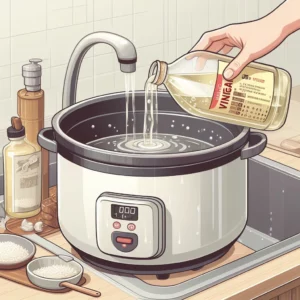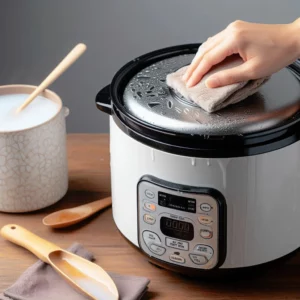Expert Tips for Ultimate Hygiene | How to Clean Your Rice Cooker Like a Pro
A rice cooker is a beloved kitchen appliance that simplifies the process of cooking fluffy, perfectly steamed rice. However, just like any other kitchen tool, it requires regular maintenance and cleaning to ensure its longevity and performance. Neglecting your rice cooker’s maintenance can lead to burnt rice, unpleasant odors, and even hygiene issues. In this comprehensive guide, we’ll explore how to clean a rice cooker and delve into various aspects of rice cooker maintenance, including cleaning tips, mold prevention, and safety precautions. So, let’s dive in and make sure your trusty rice cooker stays in pristine condition.
How to Clean a Rice Cooker
Cleaning your rice cooker is a fundamental aspect of its maintenance. Here’s a step-by-step guide on how to clean a rice cooker effectively.
Unplug the rice cooker and wait for it to cool down before cleaning.
Remove the inner pot and wash it with warm, soapy water. Use a soft sponge or cloth to avoid scratching the pot’s surface.
Be cautious not to submerge the entire rice cooker in water, as it can damage the electrical components. Instead, wipe the exterior with a damp cloth.
Pay special attention to the steam vent and the area around it. Use a small brush or a cotton swab to dislodge any food particles that may have accumulated.
For stubborn stains, a mixture of baking soda and water can be effective. Apply it to the stains, let it sit for a few minutes, and then scrub gently.
Wipe the heating plate with a damp cloth to remove any rice residue.
Finally, ensure all parts are thoroughly dry before reassembling your rice cooker.
Rice Cooker Maintenance
Rice cooker maintenance goes beyond just cleaning; it involves regular care and attention to detail. Here’s what you need to know.
Regularly check the power cord and plug for any signs of damage. If you notice any issues, replace them promptly to avoid electrical hazards.
Inspect the rubber gasket around the inner lid. If it’s damaged or worn, replace it to maintain the cooker’s seal, which is essential for proper cooking.
Clean the exterior of the rice cooker regularly to prevent dust and grime from accumulating. Use a mild cleaner or a mixture of vinegar and water for an eco-friendly option.
Now, let’s explore some essential rice cooker cleaning tips in detail.
Rice Cooker Cleaning Tips
Cleaning your rice cooker is not just about keeping it looking nice; it’s also about ensuring the appliance functions optimally. Here are some cleaning tips to keep in mind.
Regular Cleaning
Clean your rice cooker after each use. Leaving rice or food residue in the cooker can lead to burnt-on stains that are more challenging to remove.
Vinegar Cleaning
To remove mineral deposits and stubborn stains, mix a solution of equal parts water and vinegar. Use this solution to clean the inner pot and the heating plate.
Use Soft Materials
Avoid abrasive cleaning materials that can scratch the inner pot or the cooker’s surface. Opt for soft sponges or microfiber cloths.
How to Clean Rice Cooker with Vinegar

Rice cookers are a convenient way to cook rice, but they can also become dirty over time. If you don’t clean your rice cooker regularly, it can start to smell and develop mold. Cleaning your rice cooker with vinegar is a quick and easy way to keep it clean and free of bacteria.
To clean your rice cooker with vinegar, you will need
- 1 cup of white vinegar
- 1 cup of water
- A clean cloth or sponge
Instructions
- Pour the vinegar and water into the rice cooker.
- Turn on the rice cooker and set it to cook for 10 minutes.
- After 10 minutes, turn off the rice cooker and let it cool completely.
- Use the cloth or sponge to wipe down the inside of the rice cooker.
- Rinse the rice cooker with warm water.
- Dry the rice cooker with a towel.
By following these steps, you can easily clean your rice cooker and keep it free of bacteria.
Benefits of Cleaning Rice Cooker with Vinegar
There are many benefits to cleaning your rice cooker with vinegar, including:
- It can help to remove stubborn stains and odors.
- It can help to prevent the growth of bacteria.
- It can help to extend the lifespan of your rice cooker.
Overall, cleaning your rice cooker with vinegar is a simple and effective way to keep it clean and sanitary. It is a natural and inexpensive solution that can help to extend the lifespan of your rice cooker.
Tips for Cleaning Rice Cooker with Vinegar
Here are some tips for cleaning your rice cooker with vinegar:
- Use white vinegar, not apple cider vinegar or other types of vinegar.
- Fill the rice cooker with equal parts vinegar and water.
- Turn on the rice cooker and let it cook for 10 minutes.
- Turn off the rice cooker and let it cool completely.
- Use a soft cloth or sponge to wipe down the inside of the rice cooker.
- Rinse the rice cooker thoroughly with water.
By following these tips, you can clean your rice cooker with vinegar and keep it looking and smelling its best.
Common Mistakes to Avoid When Cleaning Rice Cooker with Vinegar
When cleaning your rice cooker with vinegar, there are a few common mistakes to avoid. These include:
- Not using enough vinegar.
- Using too much vinegar.
- Not cleaning the rice cooker thoroughly.
- Not rinsing the rice cooker thoroughly.
To avoid these mistakes, be sure to follow the instructions in the cleaning guide carefully. If you are unsure about how to clean your rice cooker, it is best to consult the manufacturer’s instructions.
Cleaning Rice Cooker After Use
Once you’ve enjoyed a delicious meal prepared in your rice cooker, it’s important to clean it thoroughly to maintain its hygiene and extend its lifespan. Here’s a more detailed look at post-cooking cleaning:
Prompt Action
After your rice has cooked, unplug the appliance and remove the inner pot. Leaving cooked rice inside for too long can make it stickier and harder to clean.
Food Residue Removal
Gently scrape off any stuck rice or food from the inner pot using a wooden or plastic utensil. Avoid metal utensils, as they can scratch the pot.
Soaking
If you’re dealing with stubborn residues, fill the pot with warm, soapy water and let it soak for a while. This will loosen any remaining food particles.
Rinse and Dry
Rinse the inner pot thoroughly, ensuring all soap residues are removed. Dry it completely before reinserting it into the rice cooker. Moisture left inside can lead to mold growth and affect the appliance’s performance.
Now, let’s delve into maintaining the overall hygiene of your rice cooker, a crucial aspect to ensure your meals are both tasty and safe to eat.
Rice Cooker Hygiene
Maintaining proper hygiene in your rice cooker is vital to avoid any contamination of your cooked rice and other foods. Here’s how to ensure your rice cooker remains a clean and safe kitchen appliance.
Regular Sanitization
Periodically, disinfect the inner pot and other parts of the rice cooker to eliminate any bacteria or germs. A mixture of water and a food-safe disinfectant can be used for this purpose.
Lid and Seals
Pay close attention to the lid and any seals or gaskets. These areas are prone to trapping moisture and food residues, which can lead to mold growth. Clean them thoroughly and allow them to dry completely.
Prevent Cross-Contamination
Avoid cooking other foods, like oatmeal or quinoa, directly in the rice cooker without cleaning it in between. Cross-contamination can occur, altering the taste and safety of your meals.
Removing Burnt Rice from Rice Cooker
Sometimes, despite your best efforts, rice can burn and stick to the bottom of the inner pot. Don’t worry; it’s a common issue. Here’s how to tackle burnt rice effectively.
Soak and Scrape
After unplugging and cooling down the rice cooker, fill the inner pot with warm, soapy water. Let it soak for a while to loosen the burnt rice. Then, use a non-abrasive sponge or plastic spatula to gently scrape off the burnt residues.
Baking Soda Solution
For stubborn burnt-on rice, create a paste using baking soda and water. Apply this paste to the affected area, let it sit for a few minutes, and then scrub gently. The baking soda’s abrasive properties help remove burnt rice without scratching the pot.
Rinse and Dry
Thoroughly rinse the inner pot, ensuring all cleaning agents are removed. Dry it completely to prevent any future burning issues.
Cleaning Rice Cooker Lid

The rice cooker lid is often overlooked when cleaning, but it’s an essential part of ensuring your appliance remains in top condition. Here’s how to clean it properly.
Unplug and Cool Down
As always, start by unplugging the rice cooker and allowing it to cool down.
Remove the Lid
Take off the lid from the rice cooker. Some lids can be disassembled for a more thorough cleaning; if yours can, do so.
Wash with Soapy Water
Wash the lid with warm, soapy water. Pay attention to any crevices or grooves where food particles or residue might accumulate.
Check the Seals
Inspect any rubber seals or gaskets on the lid. These should be cleaned and dried thoroughly to prevent mold or odors from developing.
Rinse and Dry
Rinse the lid and seals with clean water and ensure they are completely dry before reattaching the lid to the rice cooker.
Rice Cooker Mold Prevention
Preventing mold growth in your rice cooker is crucial for maintaining a healthy and safe kitchen environment. Let’s explore some tips to keep mold at bay.
Thorough Drying
After each use, make sure the inner pot, lid, and any seals are completely dry before reassembling the cooker. Moisture is a breeding ground for mold.
Regular Cleaning
Establish a routine for cleaning your rice cooker. This includes the inner pot, the lid, and any removable parts. Use a food-safe disinfectant periodically to prevent mold from taking hold.
Store Properly
When your rice cooker is not in use, leave the lid slightly ajar to allow for ventilation. This can help prevent moisture buildup inside the appliance.
Rice Cooker Cleaning Hacks
Cleaning your rice cooker doesn’t have to be a cumbersome chore. There are some clever cleaning hacks that can make the process more efficient and enjoyable.
Lemon Juice
To remove stubborn stains or odors, a mixture of lemon juice and water can work wonders. The natural acidity of lemon helps break down stains and leaves a fresh, clean scent.
Steam Cleaning
After cooking rice, pour some water into the empty pot, switch the cooker to “warm,” and let it steam. This can help loosen any stuck rice and make it easier to clean.
Cooking Spray
Before cooking, lightly spray the inner pot with cooking spray. This can help prevent rice from sticking to the bottom, making cleanup easier.
Lid Storage
Store the rice cooker lid upside down when not in use to allow better air circulation, reducing the chances of mold or unpleasant odors developing.
Rice Cooker Stain Removal
Stains on your rice cooker’s inner pot can be unsightly and sometimes affect the taste of your rice. Here’s how to effectively remove them.
Baking Soda Paste
Create a paste with baking soda and water, then apply it to the stained areas. Allow it to sit for a few minutes before gently scrubbing. The baking soda’s mild abrasiveness helps lift stains.
Vinegar Solution
If the stains are particularly stubborn, a mixture of white vinegar and water can be effective. Let it soak for a few hours before scrubbing and rinsing.
Non-Abrasive Scrubbers
Use non-abrasive scrubbers like nylon brushes or soft sponges to avoid scratching the pot.
Regular Cleaning
To prevent stubborn stains, clean your rice cooker promptly after each use. The quicker you address residues, the easier they are to remove.
Deep Cleaning Rice Cooker
Every once in a while, it’s a good idea to perform a deep cleaning of your rice cooker to ensure it’s in top shape. Here’s how you can achieve a thorough clean.
Disassembly
If your rice cooker allows, disassemble any removable parts such as the inner pot, steam tray, and lid. This will make it easier to clean every nook and cranny.
Soaking
Fill the sink or a basin with warm, soapy water and let the removable parts soak for a few hours. This will help to loosen any stubborn residues.
Scrubbing
Use a non-abrasive scrubber or brush to clean the inner pot, steam tray, and lid thoroughly. Pay special attention to any stains or stuck-on food.
Vinegar Cleaning
For mineral deposits on the heating plate or other areas, consider using a vinegar solution. As previously mentioned, mix equal parts of water and white vinegar, apply it to the affected areas, and scrub gently.
Drying
Ensure that all parts are completely dry before reassembling the rice cooker. This helps prevent mold growth and maintain the appliance’s performance.
Rice Cooker Cleaning Products

While many effective cleaning solutions can be made at home, there are also commercial rice cooker cleaning products available. Here’s how to use them effectively.
Read Instructions
Always follow the manufacturer’s instructions when using commercial cleaning products. Different products may have specific recommendations.
Safety Precautions
Some commercial cleaners can be abrasive or contain strong chemicals. Ensure you use them in a well-ventilated area, wear gloves, and keep them away from food.
Rinse Thoroughly
After using a commercial cleaner, be sure to rinse all parts of the rice cooker thoroughly to remove any residues of the product.
Rice Cooker Maintenance Routine
Maintaining a regular maintenance routine for your rice cooker is the key to keeping it in optimal condition. Here’s a guide to establish a maintenance schedule.
Daily Cleaning
After each use, clean the inner pot and wipe down the exterior of the rice cooker. This prevents food residues from hardening and makes deep cleaning easier.
Weekly Check
Once a week, inspect the power cord, plug, and rubber seals or gaskets for any signs of wear or damage. Promptly replace any damaged components.
Monthly Deep Clean
Set aside time each month for a deep cleaning session, which includes disassembling removable parts and giving the entire appliance a thorough cleaning.
Seasonal Checks
Depending on your usage, it’s a good idea to perform more detailed checks and cleaning at least a few times a year, especially in environments where mold growth is a concern.
Rice Cooker Maintenance Checklist
To help you keep track of your rice cooker’s maintenance, here’s a checklist you can use:
Daily
Clean the inner pot and wipe down the exterior.
Weekly
Inspect the power cord and plug for damage.
Check rubber seals or gaskets for wear and tear.
Monthly
Disassemble removable parts and perform a deep cleaning.
Seasonally
Pay special attention to areas prone to mold growth if you live in a humid environment.
Rice Cooker Disinfection
Disinfecting your rice cooker is vital to maintain food safety and hygiene. Here’s how you can do it.
Unplug and Disassemble
Always start by unplugging your rice cooker and disassembling removable parts like the inner pot and steam tray.
Disinfectant Solution
Create a disinfectant solution by mixing water with a food-safe disinfectant or a few drops of bleach. Ensure the solution is appropriate for kitchen appliances.
Soaking
Place the removable parts in the disinfectant solution and allow them to soak for at least 10-15 minutes. This helps eliminate bacteria and germs.
Scrub and Rinse
After soaking, scrub the parts gently using a soft sponge or brush. Pay special attention to seams and crevices where residue might hide. Rinse thoroughly with clean water.
Dry Completely
Allow all parts to air dry completely before reassembling your rice cooker.
Disinfecting your rice cooker is especially important if you’ve used it to cook various foods, as it ensures that your rice cooker is safe for preparing meals.
Eco-Friendly Rice Cooker Cleaning
If you prefer eco-friendly cleaning methods, there are natural solutions you can use to maintain your rice cooker.
Vinegar and Baking Soda
A mixture of white vinegar and baking soda can effectively remove stains and mineral deposits. Sprinkle baking soda, then spray vinegar and scrub gently.
Lemon Juice
Lemon juice not only removes stains but also leaves a fresh scent. Apply lemon juice to stains, let it sit for a few minutes, and then scrub.
Boiling Water
Periodically, boil a pot of water in your rice cooker without any rice or food. This helps remove any lingering odors and residues.
Cleaning Rice Cooker Gasket
The gasket, or rubber seal, is an essential component of your rice cooker, ensuring a tight seal for proper cooking. Here’s how to clean and maintain it.
Unplug and Disassemble
As always, begin by unplugging the rice cooker and disassembling any removable parts.
Gasket Removal
Carefully remove the gasket from the lid. If it’s difficult to remove, gently use a non-abrasive tool, like a plastic spoon, to lift it from its groove.
Wash and Rinse
Wash the gasket with warm, soapy water, being mindful of any food or debris trapped in its grooves. Rinse it thoroughly to ensure all soap residues are gone.
Check for Damage
Inspect the gasket for signs of wear, tears, or deformation. If you notice any issues, it’s a good idea to replace the gasket to maintain a proper seal.
Dry Completely
Allow the gasket to air dry completely before reattaching it to the lid.
Rice Cooker Cleaning Safety Tips
While maintaining your rice cooker is essential, it’s equally important to follow safety precautions. Here are some safety tips for cleaning your rice cooker.
Unplug and Cool Down
Always unplug the rice cooker and allow it to cool down before cleaning. This prevents electrical accidents and burns.
Use Safe Cleaning Products
If you use commercial cleaning products, ensure they are safe for kitchen appliances. Avoid harsh chemicals that can leave residues or fumes.
Ventilation
Maintain proper ventilation when using cleaning products. Open windows or use exhaust fans to prevent inhaling strong odors or fumes.
Wear Gloves
If you’re handling cleaning solutions or abrasive materials, wearing gloves can protect your skin.
Dry Thoroughly
Ensure all parts are completely dry before reassembling the rice cooker. Moisture can cause electrical issues and mold growth.
Rice Cooker Cleaning Conclusion and Recap
This comprehensive guide covers every aspect of maintaining and cleaning your rice cooker, ensuring it remains a trusty companion in your kitchen for years to come. Let’s recap some key takeaways.
Regular Cleaning
Clean your rice cooker promptly after each use. This simple habit prevents food residues from hardening, making deep cleaning more manageable.
Deep Cleaning
Periodically, take the time to perform a deep cleaning, which includes disassembling removable parts and thorough scrubbing.
Safety Precautions
Always prioritize safety. Unplug your rice cooker before cleaning, use safe cleaning products, and ensure proper ventilation.
Eco-Friendly Cleaning
Consider eco-friendly cleaning methods using natural ingredients like vinegar, baking soda, and lemon juice.
Gasket Maintenance
Don’t forget to clean and inspect the rubber gasket to maintain a proper seal for cooking.
Maintenance Routine
Establish a maintenance routine to ensure that you don’t overlook any essential tasks.
By following these guidelines and tips, you’ll not only keep your rice cooker in excellent condition but also guarantee that your meals are cooked safely and hygienically.
Whether you’re a seasoned chef or just getting started in the kitchen, taking good care of your rice cooker is a simple yet effective way to enhance your cooking experience and enjoy delicious, perfectly steamed rice every time.

